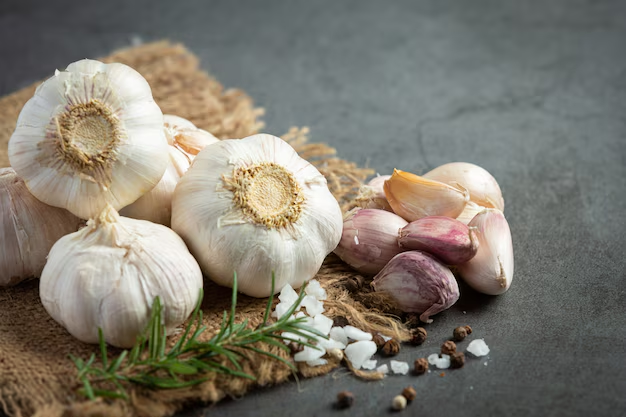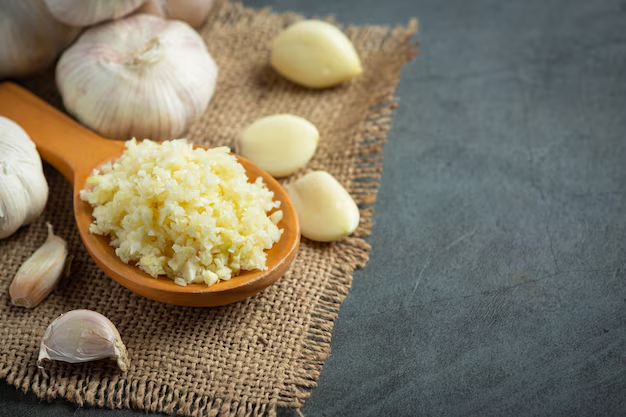Is garlic a vegetable? The answer is a resounding yes. Classified as a root vegetable, garlic is part of the Allium genus, which includes onions and leeks. Known for its potent flavor and aroma, garlic plays a vital role in both culinary creations and traditional medicine.
Its versatility makes it a kitchen staple worldwide, and its health benefits, backed by science, intrigue those seeking natural remedies. Whether you’re curious about its classification or its uses, understanding garlic’s nature is both fascinating and practical.
What is Garlic?
Garlic, scientifically named Allium sativum, is a perennial plant belonging to the Amaryllidaceae family. As a member of the Allium genus, garlic shares its lineage with onions, shallots, and chives. It is categorized as a bulb, a type of root vegetable, due to its underground growth habit and nutrient storage in its cloves.
This classification makes garlic distinct from leafy greens or seed-producing vegetables. Its bulbous structure supports its rich nutrient profile and ability to thrive in various climates.
Garlic in Culinary Terms
In the culinary world, garlic often takes on the role of a spice or herb. This confusion arises from its intense flavor, which can transform the simplest dishes. However, garlic is primarily a vegetable used as a flavoring agent.
From pasta sauces to stir-fries, garlic finds its place in countless cuisines. Its ability to balance sweetness and spiciness makes it a favorite ingredient. Whether sautéed, roasted, or minced, its adaptability has solidified its position in kitchens around the globe.
Types of Garlic
Hard-neck Garlic
Hard-neck garlic varieties are popular for their robust flavor and ease of peeling. These types thrive in cold climates and develop a woody flower stalk, known as a scape, which adds an additional culinary use.
- Features: Stronger taste, larger cloves, and a more complex flavor profile.
- Popular Types:
- Rocambole: Rich and spicy, perfect for roasting.
- Porcelain: Large cloves with a clean, bold flavor.
- Purple Stripe: Mildly sweet, ideal for baking and grilling.
Hard-neck garlic has a shorter shelf life but is prized for its quality.
Soft-neck Garlic
Soft-neck garlic varieties are better suited for warmer climates. Unlike hard-neck varieties, they lack a scape and are more compact, with multiple layers of smaller cloves.
- Features: Longer shelf life and milder flavor.
- Popular Types:
- Artichoke: Known for its slightly tangy flavor, often seen in supermarkets.
- Silverskin: Commonly used in braids for its durability.
- Creole: Distinctive pinkish-red cloves, mild and sweet.
Comparison: Hard-neck vs. Soft-neck Garlic
| Feature | Hard-neck Garlic | Soft-neck Garlic |
| Flavor | Strong, bold | Mild, subtle |
| Climate Suitability | Cold | Warm |
| Storage | Shorter shelf life | Longer shelf life |
| Clove Size | Larger, fewer | Smaller, more numerous |
To Read: Is Garlic Bread Healthy? Health Benefits and Recipes!
Nutritional Profile of Garlic
Garlic is a powerhouse of essential nutrients. Despite its small size, it offers significant health benefits.

- Vitamins: Garlic is rich in vitamin B6, which supports brain health, and vitamin C, a potent antioxidant.
- Minerals: It contains selenium, manganese, and calcium, all vital for bone and immune health.
- Fiber: Garlic aids digestion with its dietary fiber.
- Calories: A single clove contains about 4 calories, making it a low-calorie addition to meals.
Bioactive Compounds
Garlic owes much of its health benefits to its sulfur compounds, particularly allicin. Allicin forms when garlic is crushed or chopped, releasing its characteristic pungency.
- Allicin’s Role: It acts as a natural antibiotic, helps lower cholesterol, and supports cardiovascular health.
- Other Compounds: Garlic also contains diallyl disulfide and s-allyl cysteine, which have anti-inflammatory and antioxidant properties.
Comparison with Other Vegetables
Garlic’s nutritional profile sets it apart from other root vegetables like onions and carrots
| Nutrient | Garlic (per 100g) | Onion (per 100g) | Carrot (per 100g) |
| Calories | 149 | 40 | 41 |
| Vitamin C (%) | 31% | 12% | 9% |
| Fiber (g) | 2.1 | 1.7 | 2.8 |
| Key Compound | Allicin (sulfur) | Quercetin (antioxidant) | Beta-carotene (vitamin A) |
Garlic stands out for its potent bioactive compounds, which are less prevalent in other vegetables.
Health Benefits of Garlic
Here are the details of garlic’s health benefits.
Cardiovascular Health
Garlic has earned a reputation as a heart-friendly food. It helps lower blood pressure and reduces cholesterol levels, both of which are significant risk factors for heart disease. The sulfur compounds, especially allicin, play a key role in relaxing blood vessels and improving circulation.
Regular consumption of garlic may also reduce arterial plaque buildup, improving overall cardiovascular health. Whether taken fresh or as a supplement, garlic supports a strong and healthy heart.
Immune System Support
Garlic has potent antimicrobial and antifungal properties. These make it an effective tool for fighting infections. Compounds like allicin help the body fend off harmful bacteria, viruses, and fungi.
Consuming garlic during cold and flu seasons can boost immunity. Historically, it has been used as a natural remedy for treating respiratory and digestive infections. Incorporating garlic into your diet can give your immune system a much-needed boost.
Antioxidant Effects
Garlic is rich in antioxidants, which combat oxidative stress in the body. Oxidative stress is linked to chronic inflammation and aging. Garlic’s antioxidants, such as selenium and allicin, help neutralize harmful free radicals.
This reduces inflammation and supports cellular repair. Regular intake may lower the risk of diseases like cancer and Alzheimer’s. Adding garlic to your meals is an easy and flavorful way to enhance your body’s defenses against aging and chronic conditions.
Weight Management and Metabolism
Garlic is a low-calorie flavor enhancer that supports healthy eating habits. It can boost metabolism and promote fat-burning processes. Studies suggest that garlic may regulate blood sugar levels, which is essential for weight management.
Its ability to curb appetite and reduce cravings also makes it a useful tool in weight loss diets. By replacing high-calorie flavorings with garlic, you can make meals both healthier and tastier.
Historical and Medicinal Uses
Garlic has been a cornerstone of traditional medicine for centuries. Ancient cultures used it to treat various ailments, from infections to fatigue. Modern science validates many of these practices. Studies show that garlic can support digestion, detoxify the body, and improve overall well-being.
It is also used in complementary medicine to manage conditions like arthritis and diabetes. Garlic’s long-standing medicinal value underscores its importance in both history and health.
To Read: Roasted Garlic Smashed Potatoes & A New Tradition
Culinary Uses of Garlic

Fresh Garlic vs. Processed Garlic
Fresh garlic offers a superior flavor and nutritional profile compared to processed forms like pre-minced garlic or garlic powder. Crushing fresh cloves activates allicin, the compound responsible for its health benefits.
In contrast, processed garlic often loses its potency during manufacturing. Fresh garlic is also free of preservatives and offers a more intense aroma and taste. For the best results, choose fresh cloves whenever possible.
Cooking Tips
Cooking with garlic requires some care to preserve its flavor and benefits. Avoid overcooking, as this can make it bitter and destroy its bioactive compounds. To maximize its health properties, let crushed garlic sit for 10 minutes before cooking.
Store garlic in a cool, dry place to prevent sprouting or spoilage. With these simple tips, you can enjoy the full potential of garlic in your dishes.
Recipes and Applications
Garlic shines as a key ingredient in many cuisines. Here are some popular dishes that celebrate its flavor:
- Garlic Bread: A comforting side dish for pasta or soups.
- Roasted Garlic Spread: A creamy, sweet addition to sandwiches or as a dip.
- Garlic-Infused Olive Oil: Perfect for drizzling over salads or pasta.
- Garlic Soup: A nourishing and immune-boosting comfort food.
From appetizers to main courses, garlic brings a depth of flavor that transforms ordinary meals into extraordinary experiences.
Growing and Harvesting Garlic
Growing Garlic at Home
Garlic is surprisingly easy to grow at home. Here’s how:
- Choose Cloves: Use large, healthy cloves for planting.
- Prepare the Soil: Garlic thrives in well-drained, nutrient-rich soil.
- Plant: Push the cloves into the soil with the pointed end up, about 2 inches deep and 6 inches apart.
- Water: Keep the soil moist but not waterlogged.
- Mulch: Apply a layer of mulch to protect against weeds and retain moisture.
With minimal effort, you can enjoy a fresh garlic harvest.
When and How to Harvest
Garlic is ready to harvest when its leaves turn yellow and start to dry. Gently dig around the bulbs to avoid damage. After harvesting, allow the bulbs to cure in a dry, well-ventilated space for about two weeks. Proper curing enhances flavor and extends storage life.
Common Mistakes in Garlic Farming
Avoid these pitfalls for a successful garlic crop:
- Overwatering: This can lead to root rot.
- Planting Too Shallow: Leaves bulbs exposed and prone to damage.
- Using Poor-Quality Cloves: Small or damaged cloves yield weak plants.
With care and attention, you can grow healthy, flavorful garlic at home.
Frequently Asked Questions
Is Garlic a Root Vegetable?
Yes, garlic is classified as a root vegetable. It grows underground, with its edible bulb storing energy. Botanically, it’s part of the Allium genus, making it closely related to onions and leeks.
Can Garlic Be Grown Indoors?
Yes, garlic can be grown indoors. Use a deep pot with good drainage and nutrient-rich soil. Place it near a sunny window for at least 6 hours of sunlight daily. Water sparingly, and you’ll have fresh garlic year-round.
Is Garlic a Superfood?
Garlic is often considered a superfood due to its health benefits. It boosts immunity, improves heart health, and combats inflammation. Its high nutrient density and medicinal properties justify its inclusion in the superfood category.
Conclusion
Garlic is much more than a simple vegetable. Its rich history, diverse culinary applications, and proven health benefits make it a staple in kitchens and medicine cabinets alike. Whether you grow it at home or buy it fresh, incorporating garlic into your diet is a flavorful way to boost your well-being. Start exploring the many uses of garlic today and unlock its full potential in your life.

